Forward into Fall
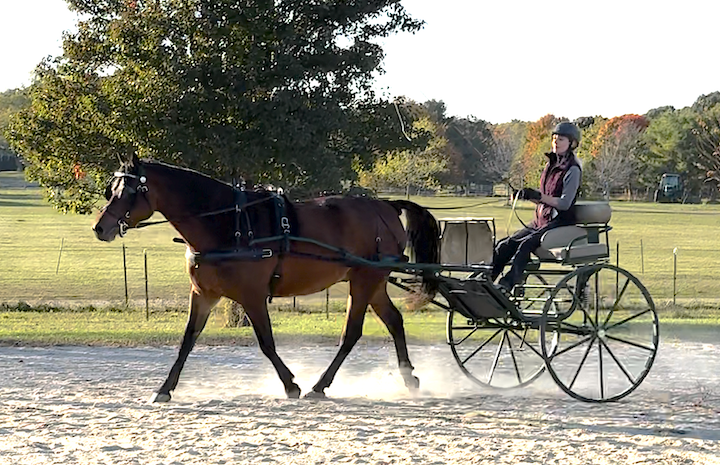
We've made the most of these warm, gorgeous Fall days by pushing for major progress in Levi's driving and riding training. In my last post, I shared that I had started him riding at the end of July. He was ready then, and he remains so now. We've consistently ridden at least two days per week since then in his bareback pad (a Werner Christ fur saddle). We currently alternate riding and driving days, basing the workout and workload on his thresholds and conditioning/schooling needs. Our workout progression has followed the outline I shared in the last post, with a few twists, for excellent results. At the end of September, Levi wanted to do a little bit more than ring work. I replied, "OK, but if we're heading out into the wide world, could I please have stirrups now??" While riding in the stirrup-less bareback pad has cemented a solid place for a weekly workout, in order to make more progress with a green horse learning to balance a rider at all three gaits, we needed a good saddle. Fortunately, I found one, and I think it fits him very well. Did we really get this right on the first try? Saddle fitting is usually an arduous process. While I do have a saddle fitter coming out this week to give us the thumbs up or thumbs down regarding the saddle I chose, after three rides in this saddle (with stirrups- thanks Levi!), I am already seeing some great progress.
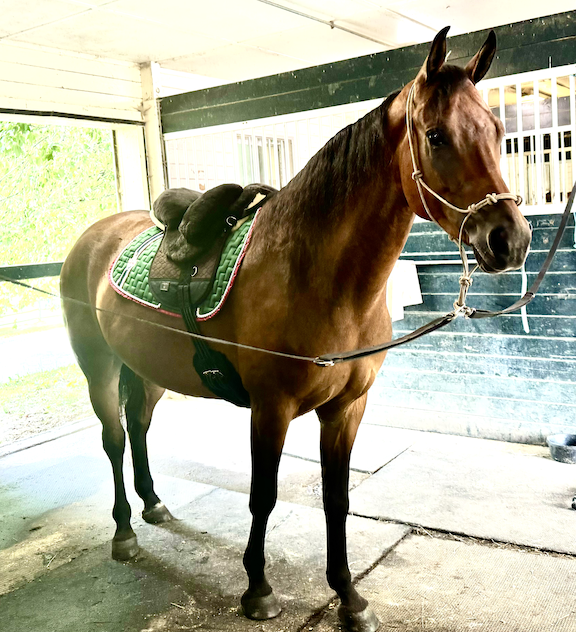
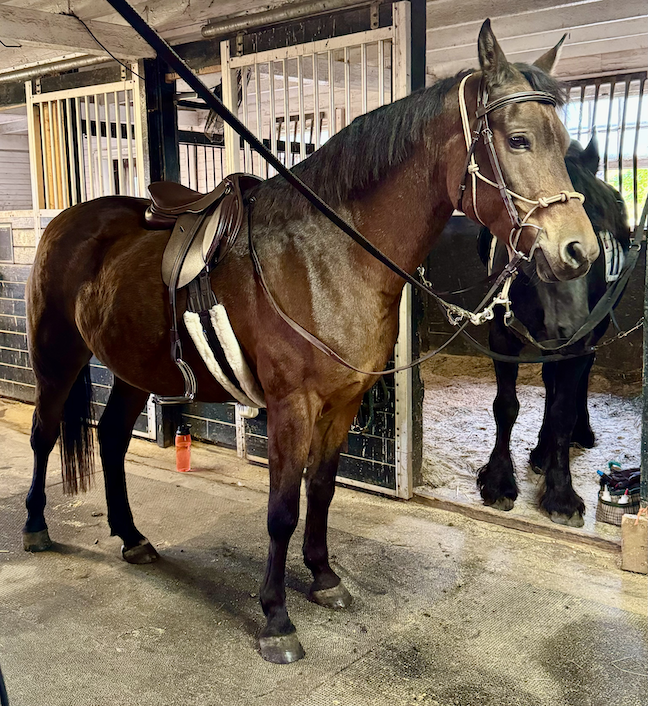
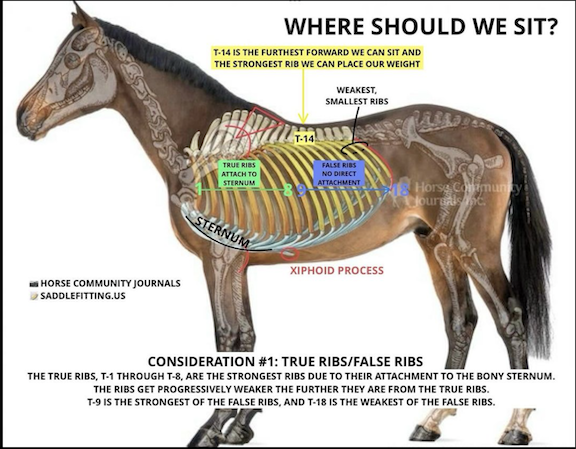
Progression: Levi in his Werner Christ Fur Saddle (left), which we rode in for two months, and in his new Henry de Rivel close-contact jumping saddle (center). The right image was one I found informative - if you had difficulty as I did in fitting a saddle, this image (and instagram account listed on it as the source of the image) was helpful. Considering there are so few places to safely center our body weight and balance on the horse's back, it's a wonder we can ride them at all.
In addition to riding, we have been driving also, and I feel that starting Levi under saddle has actually improved our driving. I have not been great about getting routine photos and footage of all of our workouts. One great step forward is that I have taught Levi how to ground tie, meaning I can drop his lead rope and have him stand quietly to be hitched without a header. While in principle I didn't agree with doing this at the outset, the reality is that I can't always rely on others to help me, and if I don't learn how to hitch alone safely, I won't be able to drive as often as we need to keep up both fitness and training progress. It's a tradeoff and a risk I was willing to make; so far, we have had zero problems. I have put Levi to his cart myself multiple times in different settings and I feel it has not only made us better and more confident drivers, but has improved our focus and our relationship as well. "Just the two of us" is the way we prefer to work at this point.
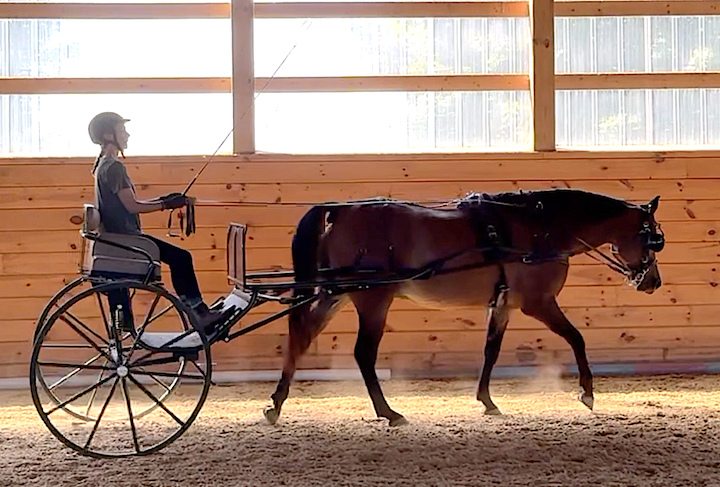
I made a few modifications to his tack that have helped him; I noticed a while ago that while he was interacting with his bit and going on the bit in the cart, on occasion he would kind of hold the bit instead of really working and responding to it. I watched this pattern for several days and then thought perhaps he would be happier if the reins had less motion, the bit was more level in his mouth, and the signals were all clearer. The way to accomplish this, in addition to being relentless with myself about keeping still and quiet hands and a good position in the cart, was to change his bit. Levi was driven in a 3-piece jointed snaffle with a butterfly cheek piece; the bit accommodates a curb chain which I usually do not drive with, and I always drive with the rein on the ring closest to the cheek, which you can see above and in our videos. I realized that, due to the physics of driving vs. riding, a snaffle bit may not be the best option for a green horse that one wishes to get on the bit, because of the greater weight of the driving reins and how we interact with them to communicate with the horse. Levi likes the butterfly cheek piece, so I kept that and switched him to a version with a curved copper Mullen mouthpiece instead of the 3-piece snaffle. I was happy to see that he responded much better immediately; I feel that I can help him accept contact much more readily with this mouthpiece, and the 'signal to noise' ratio is improved for him. Bitting is voodoo and I don't claim to know even half of what I should about it. Many drivers go through this iterative process trying to find the right mouthpiece and bit for our driving horses at different stages of their training. Often, bit that would seem to be incredibly mild is actually not the right tool at a particular time, and recognizing and correcting it is important.
Some relaxed (almost too relaxed!) walk-trot transitions in the indoor. Both of us prefer to drive outside, but on this day there was a soccer match with a ton of noise outside. Most of the time I will work with whatever is going on in the background, but we were both fed up with the constant soccer games and the kids' screaming. Levi is really sensitive to loud, sudden noises, and he can't tell, based on the nature of the screaming, whether little human children are delighted with life or being brutally murdered by something that will probably try to eat him next, and reacts accordingly. You can't out-train the reactive nature of the horse, but you can work with it to bring out the best in them.
In addition to riding and driving, new schooling opportunities have injected some new momentum into our training. We participated in a classical dressage clinic at the boarding farm last month and learned many helpful pieces of information. I was so relieved, and happy, to hear the clinician affirm that Levi was, in fact, a nicely balanced and supple young horse. When you work with a horse every day, it's easy to magnify faults on a macro scale; I've worked very hard to help Levi become more balanced and symmetrical, even a little bit more ambidextrous, using different training and biomechanical approaches. It gives hope and confidence that he does feel more balanced and aligned.
A little clip from our clinic session with a classical dressage trainer. While I started out on his back, she wanted us to work on the ground to help develop his bend, which we did mostly at a trot for the rest of the session.
Finally, and most exciting for us, we participated in our first trail ride yesterday! Not only was it Levi's first ride off the property, it was also his third ride in our new saddle, and our first group ride ever! Once a green horse has the basics down in the first couple of months of rides, I think it's essential to get them out working on the trail. Trail work is a master class in putting together everything he has learned so far in the ring. He is expected to quietly go through gates and over diverse terrain, to balance himself and pay attention to his surroundings, to quickly and obediently respond to the rider's aids, and to be socially appropriate around other horses, respecting everyone's space. He is expected to lead and follow other horses without any fanfare or protest. He is expected to remain calm and responsive to the rider regardless of what other horses are doing or what is going on in the environment. Easier said than done? Well, what you tend to expect at the outset, you tend to get; if you expect you are going to get a hard time from a wild youngster, you will probably experience that. If you've carefully prepared the young horse and also are ready yourself to handle and immediately shut down any shenanigans or silliness, you will be successful. Levi did not disappoint; in fact, he and his BFF, the Friesian gelding Mozart (featured in the photos below) took turns leading a group of five horses for most of the trail ride. Levi passed the test with flying colors, but, true to form, he had a few little shies and spooks along the way. Here, I was grateful for a stable seat - when we returned to the farm, he decided that one of the bushes he sees every single day hid something that wanted to eat him, and he leapt sideways in the air like a cat. My body didn't move in the saddle, which made it much easier to just point him right down the hill afterward without fostering any interest in his excitement. No one cared about how he reacted, primarily me, and that was important; he doesn't get to set the emotional tone for the group. Channeling young horse silliness into productive energy is much easier when you are stably positioned and can sit out a spook (which is one reason why I was so grateful to be back in the irons in a nice saddle instead of a bareback pad)!
When I examined the sweat marks beneath his saddle afterward, I was pleased to see full clearance of the gullet along the spine, full clearance of the wither/trapezius, clearance of T-18 and no rub marks beneath or along the girth indicating possible pressure points. So far, so good, but the saddle fitter will confirm whether this one goes back or not. I had originally thought I'd need something custom made for Levi, but I thought better of it for a couple of reasons. One, he's young and still developing and his back is going to change dramatically over the next months under saddle, and the custom saddle he was measured for today would likely not fit him in several months! This is an expensive mistake that I can avoid. Second, it's far likelier that the local market does in fact have something that will work for him, given the number of Morgans in our region, as long as I am somewhat flexible about the style of the saddle. I don't necessarily want to do eventing, but having the type of saddle that puts me in a more active position where I feel more capable to react to sudden young horse antics, and can hover in a half seat comfortably (as was proven to me during our trail ride) is exactly what we need right now in our training. For our future trail or cross-country work, I am hopeful that this saddle will be just the ticket.
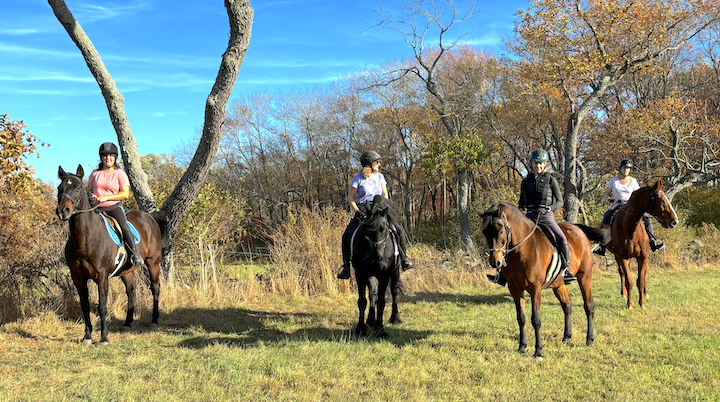
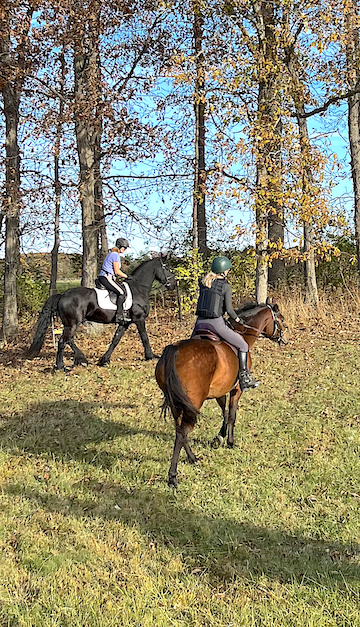
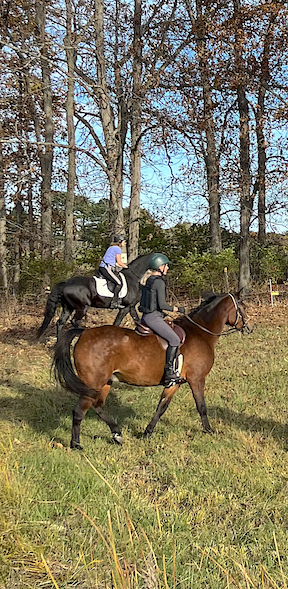
Photos from our first trail ride. In the left image, from left to right: Dolly and Gus, Kristen and Mozart, me and Levi, and Stacey and Rex. In the center and right images, Mozart and Levi are tackling their first big hill! I kind of love introducing young horses to hills because their brains start turning gears along with their bodies, trying to figure out their balance and offering all kinds of movement. I'm weird for liking this, but I do!
While Joe is still helping me with both riding and driving training, his schedule has become so busy lately that he hasn't had much time to film or assist us. However, we will plan an exciting outing this coming weekend that he's eager to participate in - we will share that footage next week! In addition to Joe, I have added a new instructor to our weekly ridden training which is going to be transformative; stay tuned for updates on this very soon, because we start private lessons this week, and I can hardly wait. We're nearing the three month mark now with riding, and Levi is at a point with my skill set where we can start to really develop as a team with some professional guidance from the ground. This instructor is actually someone who has known Levi since he was a two year old, and I'm glad we kept in touch, as I knew I wanted to work with them once we were at this point.
Levi is well on his way to becoming a steely-eyed missile man of saddle horse as well as a solid driver who will get the job done. His new nickname around the farm is "the Professional" due to his workmanlike, straightforward confidence and consistency in going where other horses fear to tread and showing them how it's done. This is the cool-headed, smooth operator I knew he could be!
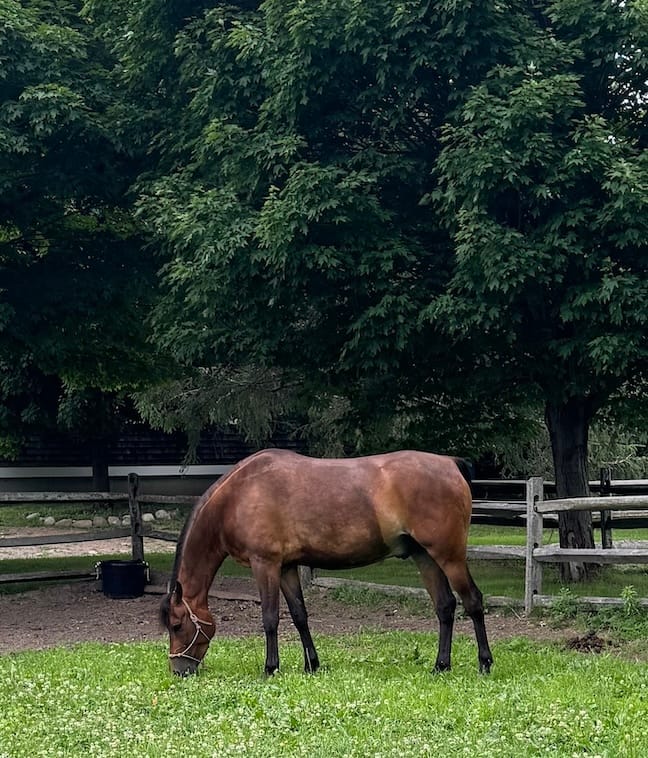
Yes, I realize I didn't talk about our final show season results (lots to share there!) and challenges, but I will do so in our next post. Can you really blame me for being so pleased and excited for him??
Member discussion